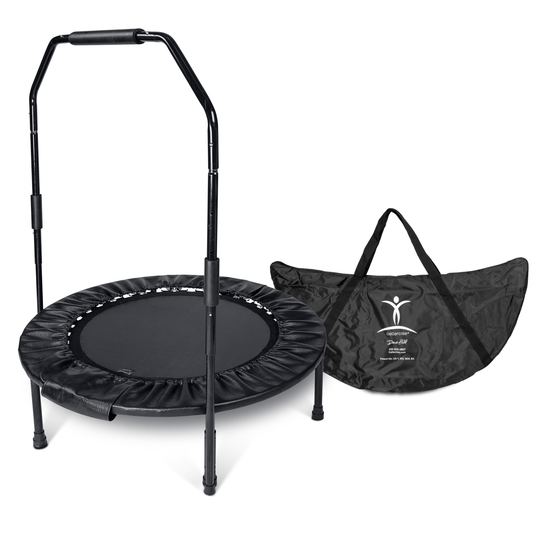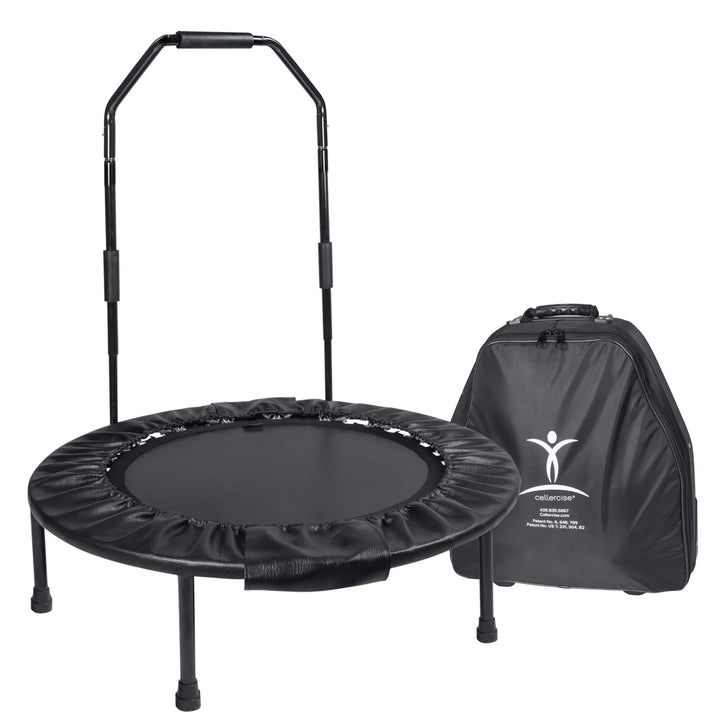Disclaimer: This Blog/Web Site is made available by the publisher for educational purposes only as well as to give general information & understanding regarding the industry. It is not to be used as specific medical advice or to replace consulting with your doctor. You should always consult with your doctor. By using this Blog / Web Site you understand that this Blog/Web Site should not be used as a substitute for medical advice from a licensed professional. For our full disclaimer, please read: Cellercise® Disclaimer
A focus on health and wellness is vital for your mental and physical well-being, and rebounding can be a part of that. Of course, we're not talking the rebounding of relationships or the type on the basketball courts, but the rebounding that involves a mini trampoline and space at home to workout. You might be wondering why is rebounding good for you, and it's a good question. You possibly already know that rebounding has a ton of health benefits, so we're not going to go over them here. What we will talk about, though, is the fact that rebounding improves your immune system and lymphatic health, as well as your mental health.
Rebounding & Your Circulation
Rebounding involves you and a mini trampoline, and jumping on this trampoline is fantastic for your lymphatic circulation. When you concentrate on exercise that helps your body to eliminate toxins, you can think about the way that your body feels - more energetic, for example. The body holds up to six pints of blood, and the heart moves this blood around from brain to toes and back again. Without the lymphatic system, there's no avenue for the body to remove toxins properly. A rebounder can change this, flushing the toxins out and helping your body to tone up at the same time. The rush of happy hormones you then get (endorphins) can drastically improve your mental health.
Rebounding & Gravity
Every single form of exercise out there works on the way we oppose gravity. Runners push against the ground to move faster; weight lifters push weights over their head until they can't hold them up. Gravity pulls on us before we are even born, and every part of the body works to oppose gravity every day. The cells in the body have to do the same thing, including the lymphocytes in our systems. Rebound exercise uses the gravity pulling on us, as well as the acceleration forces to work harder. Every time you jump on a mini trampoline, the cells in your body have to adjust to the increased deceleration before being sprung up again into the air. It takes a moment, but the body then adjusts to a weightless condition for a few seconds at a time. The good thing is that this weightlessness is through the whole body, regardless of where the cells rest.
How Does Rebounding Actually Work?
There are two different ways in which rebounding works. It's a form of cardio, and it's the cardio that helps to strengthen the heart and blood vessels as well as the lungs. It does this in the same way that running and cycling do. This means that when you increase the activity of the organs, rebounding works to improve oxygenation and trains the muscles at the same time. As well as this, it has a unique action at the same time in that the repetitive acceleration that occurs opens those lymphatic vessels we talked about earlier. It's this that improves your immune system. If you want to know is rebounding good for you, it absolutely is - for all the reasons for your body and more. It is scientifically proven to work, backed up by a landmark study that was completed almost 40 years ago in 1980. NASA scientists put their heads together and researched the benefits of rebound exercise on the human body, concluding that it is 68% more effective than jogging but requires much less effort.
What Else Did NASA Say?
The findings from the study that NASA performed showed the following:
- The G-force that was measured by the rebounders at the ankle was more than twice the G-force of those running on a treadmill.
- The use of vertical force develops more biomechanical work with less energy expended.
- Pat Mueller, director of Recreational Sports at the University of Minnesota was quoted saying, "...but this thing is so phenomenal, it's the exercise of the future...Rebound exercise is the most efficient, effective form of exercise yet devised by man."
As if you needed more convincing! The whole study was designed to look at the distribution of acceleration through the body, and they compared trampolining with being on the treadmill. The physical impact which we experience while rebounding is much more significant than running, but it's not concentrated just to the knees and ankles; it's distributed throughout the whole body. There's less pressure on the ankles and shins, which results in fewer shin splints, too. All of this reduces the risk of injuries while still giving a thorough whole-body workout.
The History of the Trampoline
Fun fact: George Nissen and Larry Griswold built the very first trampoline in the 1930s. It was used as a training tool for astronauts - which is why the NASA study makes such perfect sense - to develop their acrobatic skills. Tumblers and gymnasts could also benefit from the mini trampoline, and since then, people enjoyed the sensation so much that rebounding for fun became popular. Trampolining has been around for a very long time, if archaeological drawings in China, Egypt and Persia are to be believed. The very first world championships in trampolining happened in 1964, and the trampolines that we use today are the same as those that NASA studied.
I'm Convinced - Now What?
Choosing the right rebounder for your exercise now that you know how good it is for you is essential. Injuries occur during trampolining only when it's not done correctly. It's so vital for your health that you don't go for a cheap option when these are the ones that malfunction so quickly. Your rebounder should be made with steel if possible, as the construction lasts longer with little to no stretching.
Rebounding is good for us, science tells us so. It's just a matter of finding the right workout and enjoying it while you bounce. There's so much more to it than fitness, and you can discover this yourself with the right rebounder.
NOTE: Remember to always consult with your doctor or health professional before starting new exercise routines.
Get Your Cellerciser® and start rebounding today!
















